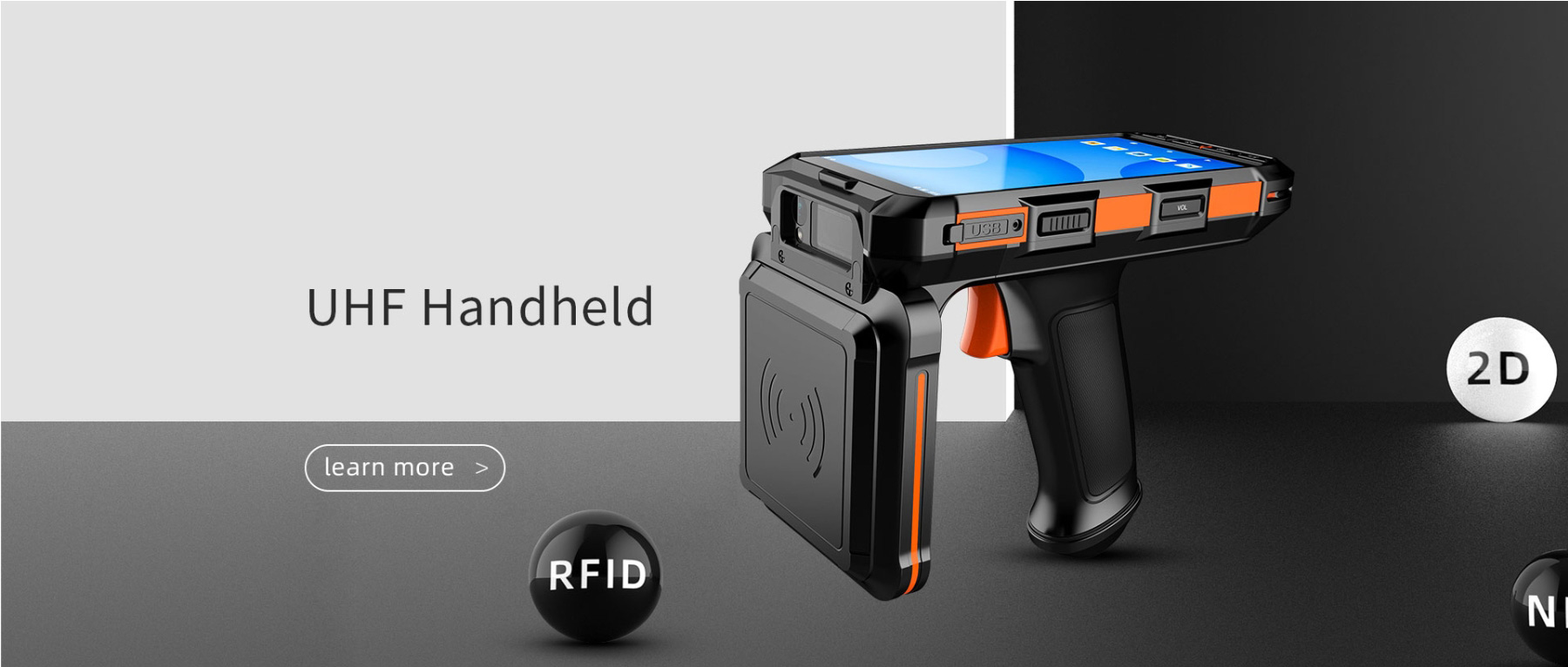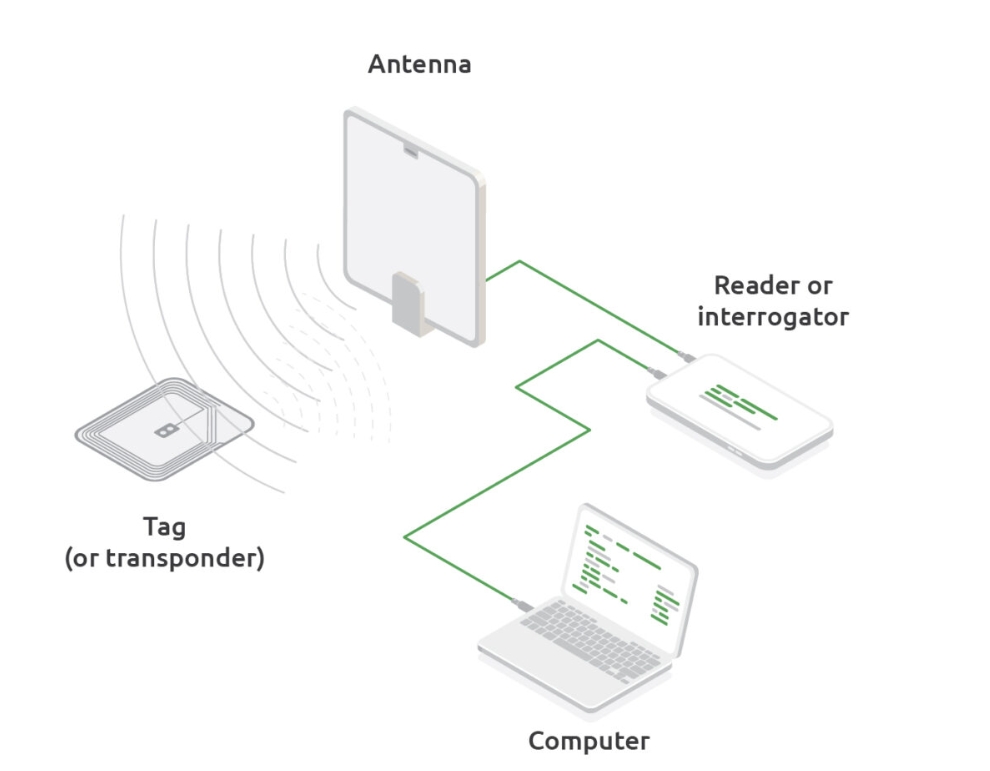 Call at :
+86 18681515767
Call at :
+86 18681515767
 Email :
marketing@jtspeedwork.com
Email :
marketing@jtspeedwork.com
 Call at :
+86 18681515767
Call at :
+86 18681515767
 Email :
marketing@jtspeedwork.com
Email :
marketing@jtspeedwork.com

UHF RFID reader terminals come in various forms. Depending on the application scenarios, the final terminal forms are different. In the industry, readers are generally classified based on whether they are in a fixed position or can be moved when used. They are divided into two categories: Fixed readers and Mobile readers. In this survey, based on market popularity, we selected large-volume and relatively high-priced products such as printers, smart cabinets, and channel reader from fixed readers for separate analysis. The specific categories are: • Handheld devices (Including other portable reader/writer devices). Among this type of products, the most important form is handheld devices. In addition, there are also some tablets and wearable products. When applied to the market, they are all classified into the same category. • Printer is a common form of RFID fixed reader and writer. It is mostly used for printing white label cards. Or the application terminal performs a small amount of re-labeling due to label loss. Or scenarios such as logistics, finance, electricity, and medical care where the number of tags is relatively small and the degree of customization is high. • Channel reader is a form of fixed reader that uses bayonet ports for warehouse entry and exit management and asset management. • Smart cabinet is a recently developed fixed reader-writer product, mostly used for asset management. • Other fixed reader/writer equipment:Excluding fixed reader/writer products other than smart cabinets, printers, and channel readers, including all-in-one machines, card issuers, and gateways Readers and writers, desktop readers and writers, cashier equipment, testing equipment, experimental equipment, etc. • Discrete device readers and writers refer to UHF RFID readers and writers built with discrete devices. They do not use standard chips. In some scenarios, such products can customized according to user needs. Especially recently, some large projects on the market have adopted this type of products,The products are available in various forms, both fixed and removable.

In recent years, smart homes have gained incredible popularity due to their ability to enhance convenience, comfort, and security. Among the many advanced technologies that power these futuristic homes, RFID (Radio Frequency Identification) technology stands out as a game-changer. With its ability to wirelessly detect and identify objects, RFID is revolutionizing the way we interact with our homes. In this article, we will explore the application of RFID technology in smart homes and provide examples of its practical use, showcasing how it is reshaping our living spaces. 1. Seamless Access Control: One of the key areas where RFID technology shines is in access control systems for smart homes. Traditional key-based access systems are being replaced by RFID-enabled solutions that offer greater convenience and security. With RFID-enabled door locks and key fobs, homeowners can effortlessly unlock doors and grant access to authorized individuals. This eliminates the need for physical keys and the hassle of carrying and managing multiple keys. Additionally, RFID access control systems can provide real-time event logs, allowing homeowners to track who entered or exited their homes and at what time. Example: Imagine coming home with your hands full of groceries. With an RFID-enabled access control system, you can simply approach the door, and it will automatically unlock as it detects the RFID tag embedded in your key fob. No need to fumble for keys or struggle to open the door. It's a seamless and convenient experience that simplifies your daily routines. 2. Personalized Home Automation: RFID technology also enables personalized home automation experiences tailored to individual preferences. By attaching RFID tags to personal items or wearable devices, homeowners can trigger customized automation scenarios when they come into proximity with RFID readers placed strategically throughout the home. This allows for a highly personalized and intuitive user experience, where the home can automatically adjust lighting, temperature, music playlists, and other settings based on individual preferences. Example: Let's say you have an RFID tag embedded in your smartphone. As you walk into your living room, the RFID reader detects your presence, and the smart home system instantly adjusts the lights to your preferred brightness, activates your favorite playlist, and sets the temperature to your desired level. It's a personalized and immersive experience that transforms your home into a tailored environment. 3. Inventory Management and Smart Appliances: RFID technology is making significant strides in revolutionizing inventory management and enhancing the capabilities of smart appliances within smart homes. By tagging items with RFID labels, homeowners can effortlessly track and manage their belongings. Smart refrigerators equipped with RFID readers can detect the contents of the fridge, monitor expiration dates, and generate shopping lists automatically. RFID-enable...
In today's rapidly evolving industrial landscape, maximizing productivity and efficiency is crucial for businesses to stay competitive. Traditional manual processes and outdated automation systems are being replaced by cutting-edge technologies, and at the forefront of this revolution is SPEEDWORK Industrial Automation Solutions. This next-generation solution is transforming industries by offering a range of advanced features and capabilities that power productivity like never before. At the heart of SPEEDWORK Industrial Automation Solutions lies its powerful and intelligent control system. Utilizing state-of-the-art hardware and software, the system seamlessly integrates with various industrial processes, allowing for centralized monitoring and control. Whether it's in manufacturing plants, logistics warehouses, or any other industrial setting, SPEEDWORK enables businesses to gain complete visibility and control over their operations. One of the standout features of SPEEDWORK Industrial Automation Solutions is its advanced data acquisition and analysis capabilities. By leveraging sensors, IoT devices, and interconnected systems, the solution collects vast amounts of real-time data from every corner of the industrial environment. This data is then analyzed using advanced algorithms and machine learning techniques, providing actionable insights and predictive analytics. Businesses can make informed decisions, optimize processes, and identify potential bottlenecks or inefficiencies, all leading to improved productivity and cost savings. SPEEDWORK Industrial Automation Solutions also harnesses the power of robotics and artificial intelligence (AI) to drive automation and streamline workflows. Collaborative robots, or cobots, work alongside human operators, automating repetitive tasks and handling labor-intensive processes. These cobots are equipped with sophisticated sensors and AI algorithms, enabling them to adapt to dynamic environments, ensure safety, and perform complex tasks with speed and precision. The integration of robotics and AI not only increases productivity but also enhances workplace safety and allows human workers to focus on more strategic and creative endeavors. Another key aspect of SPEEDWORK Industrial Automation Solutions is its seamless connectivity and integration capabilities. The system can interface with existing industrial machinery, equipment, and control systems, creating a cohesive ecosystem where disparate components work together harmoniously. This connectivity extends beyond the factory floor, enabling businesses to achieve end-to-end automation and synchronization across their supply chains. Real-time data exchange, coordinated workflows, and optimized resource allocation become a reality, facilitating agile decision-making and boosting overall productivity. Moreover, SPEEDWORK Industrial Automation Solutions incorporates advanced scheduling and optimization algorithms. By analyzing real-time data, the system can e...
Effective asset tracking and traceability are critical for industries that deal with metal assets, such as manufacturing, construction, and logistics. The ability to accurately monitor and manage these assets in real-time can streamline operations, improve efficiency, and prevent loss. UHF anti-metal RFID tags, in conjunction with RFID handheld readers and portable RFID readers, have emerged as powerful tools in unleashing traceability on metal assets, revolutionizing asset management in various industries. UHF anti-metal RFID tags are specifically designed to overcome the challenges posed by metal surfaces, which typically interfere with RFID communication. These tags are equipped with specialized shielding techniques that enable reliable communication and accurate reading even when attached to or near metal assets. This breakthrough technology has opened up new possibilities for tracking and managing metal assets efficiently. The integration of RFID handheld readers and portable RFID readers with UHF anti-metal RFID tags brings flexibility and mobility to asset tracking. RFID handheld readers are lightweight, portable devices that can be easily carried and operated by personnel. These handheld readers are equipped with UHF RFID reader modules and provide the ability to read and write data to UHF anti-metal RFID tags. They offer convenience and ease of use, allowing users to perform on-the-spot scanning and data collection, eliminating the need for fixed RFID reader installations. The use of handheld RFID scanners offers several advantages in the tracking of metal assets. Firstly, they provide real-time visibility, enabling instant identification and monitoring of assets. When a handheld RFID scanner comes into proximity with an UHF anti-metal RFID tag, it captures the tag's unique identification information and transmits it wirelessly to a central database or management system. This allows for efficient inventory management, asset tracking, and timely retrieval or maintenance operations. The portability of handheld RFID readers also facilitates asset tracking in various environments. Whether assets are located in warehouses, construction sites, or transportation hubs, the ease of carrying and using handheld RFID scanners ensures that asset data can be collected accurately and conveniently. The flexibility to scan assets in different locations and across various workflows enhances the overall efficiency and effectiveness of asset management. Additionally, the advancements in handheld RFID reader technology have contributed to their increased reliability and performance. The availability of handheld UHF RFID readers specifically designed to work with anti-metal RFID tags ensures optimal performance in challenging metal-rich environments. These handheld readers offer extended read ranges, robust communication capabilities, and fast data capture, allowing for swift and accurate identification and tracking of metal assets. When considering the adopt...
In the realm of supply chain management, efficiency is paramount. The ability to accurately track and monitor assets in real-time can streamline operations, enhance visibility, and optimize inventory management. Long-range UHF RFID tags, coupled with HF RFID modules, HF RFID reader modules, and high-frequency antennas, have emerged as powerful tools that empower supply chain efficiency, revolutionizing the industry. The utilization of UHF RFID tags equipped with HF RFID modules has become increasingly prevalent in supply chain management. UHF RFID tags operate at the ultra-high frequency range, allowing for robust communication and extended read ranges. Combined with high-frequency modules, these tags enable seamless identification and tracking of a wide array of assets, from small components to large pallets. The HF RFID reader modules serve as the gateway for data collection. These compact and versatile devices are capable of efficiently reading and processing large volumes of information from UHF RFID tags, ensuring real-time tracking and synchronization of inventory data. By integrating HF RFID reader modules into existing supply chain systems, businesses can enhance their operational visibility and obtain valuable insights into their inventory movements. The performance of UHF RFID tags and HF RFID modules greatly relies on the effectiveness of HF RFID antennas. High-frequency antennas are designed to optimize signal transmission and reception, enabling reliable and consistent communication between the tags and reader modules. These antennas come in various forms, including flat panel antennas and circular polarization antennas, providing flexibility in installation and coverage. One of the key advantages of long-range UHF RFID tags is their ability to streamline supply chain operations. With extended read ranges, assets can be automatically detected and tracked without requiring physical contact or line of sight. This facilitates efficient asset management, reduces manual labor, and decreases the likelihood of errors or loss. Additionally, the integration of UHF RFID tags and HF RFID modules improves inventory accuracy and reduces stock discrepancies. With real-time data capture, businesses can achieve better inventory visibility, accurate stock counts, and timely replenishment. This helps prevent stockouts and overstocking, leading to optimized inventory levels and improved supply chain decision-making. High-frequency modules play a crucial role in enhancing supply chain efficiency. These modules enable seamless integration with existing systems, such as warehouse management or enterprise resource planning solutions. Through the seamless exchange of data, businesses gain deeper insights into their supply chain performance, enabling proactive decision-making and the identification of potential bottlenecks or optimization opportunities. By capitalizing on the potential of long-range UHF RFID tags, HF RFID modules, and high-frequency antennas...

RFID smart cabinet refers to a reader-writer in the form of a cabinet, which is a type of fixed reader-writer. Because in recent years, a number of RFID smart cabinet players have emerged on the market. This type of product is also an industry a new growth point In terms of technology types, RFID smart cabinets mainly include two frequency bands: UHF and HF. Many smart cabinets will integrate UHF and HF capabilities. This report mainly focuses on UHF cabinets. HF smart cabinets have been commercialized earlier, especially in the field of books and archives, and are widely used. However, in recent years, UHF smart cabinets are increasing rapidly. At present, the proportion of UHF and HF cabinet products is relatively close. In recent years, RFID smart cabinets have been a bright spot in the industry. There are two main reasons. The first aspect is that the market for smart cabinets is growing rapidly, including medical, library and archives, finance, industry and other fields. For RFID smart cabinets, The demand is growing rapidly. The second aspect is that the price of smart cabinets is high and the profits are relatively good. A simple understanding of a smart cabinet is a product that combines a traditional cabinet with an RFID reader. Therefore, manufacturers of smart cabinets need to have two parts. One is the sheet metal part.It is usually outsourced, but some manufacturers do it themselves; the other part is the RFID reader part, which is the RFID manufacturer's own advantage.

Handheld (Including tablet, Handheld devices,wearable devices, etc.) refers to mobile, portable UHF RFID reader devices, of which handheld is the most common form. This type of product is characterized by lightweight, easy to move in real time, and the handheld machine can be understood as a mobile phone with UHF RFID function, in addition to RFID identification In addition to reading, it also has most functions of ordinary mobile phones, which is very suitable for storage inventory, asset management, personnel behavior management and other applications. UHF RFID mobile phone have high degree of standardization, lightweight and portable characteristics, so it's more suitable for consumer applications, once the volume, it has a high Imagination space. In the current market environment, handheld devices are mainly used in B-end scenarios such as logistics, finance, retail, and industry, and B-end scenarios are characterized by slow start, except in certain scenarios There are policies to push, so we believe that in the current market environment, the growth of handheld device shipments in the B-side scenario and the growth of the entire reader market,The degree is basically the same. One of the biggest variables in the mobile phone market is the express logistics market, and once the application of express logistics breaks out, the demand for UHF RFID mobile phones is well known.Because the market is still in the early validation stage, so when we evaluate expectations, we eliminate this factor, and we will also monitor the industry in real time Above are the latest developments, there are certain information will be updated in time.

UHF RFID reader terminals come in various forms. Depending on the application scenarios, the final terminal forms are different. In the industry, readers are generally classified based on whether they are in a fixed position or can be moved when used. They are divided into two categories: Fixed readers and Mobile readers. In this survey, based on market popularity, we selected large-volume and relatively high-priced products such as printers, smart cabinets, and channel reader from fixed readers for separate analysis. The specific categories are: • Handheld devices (Including other portable reader/writer devices). Among this type of products, the most important form is handheld devices. In addition, there are also some tablets and wearable products. When applied to the market, they are all classified into the same category. • Printer is a common form of RFID fixed reader and writer. It is mostly used for printing white label cards. Or the application terminal performs a small amount of re-labeling due to label loss. Or scenarios such as logistics, finance, electricity, and medical care where the number of tags is relatively small and the degree of customization is high. • Channel reader is a form of fixed reader that uses bayonet ports for warehouse entry and exit management and asset management. • Smart cabinet is a recently developed fixed reader-writer product, mostly used for asset management. • Other fixed reader/writer equipment:Excluding fixed reader/writer products other than smart cabinets, printers, and channel readers, including all-in-one machines, card issuers, and gateways Readers and writers, desktop readers and writers, cashier equipment, testing equipment, experimental equipment, etc. • Discrete device readers and writers refer to UHF RFID readers and writers built with discrete devices. They do not use standard chips. In some scenarios, such products can customized according to user needs. Especially recently, some large projects on the market have adopted this type of products,The products are available in various forms, both fixed and removable.
Categories
New Products
JT-6210 0-1m UHF RFID Desktop USB Reader Writer ISO18000-6C Read More
JT-7100 0-3m 860-960MHz UHF RFID Industrial Grade RFID Reader Read More
JT-8380 0-6m UHF RFID 860-960MHz Middle Range Integrated Reader Read More
JT-P983 Industrial Tablet Pad RFID Handheld Reader Grade Long Range Android UHF Terminal Bluetooth RFID Reader For Warehouse Read More
JT-1550 Small Mini HF RFID 13.56MHz Module ISO14443A ISO 15693 Protocol Read More
JT-2302A 13.56MHz RFID Module ISO14443A ISO15693 Protocol Read More
JT-2302 HF RFID 13.56MHz Module ISO14443A ISO15693 Support Mifare1 IC card Read More
JT-2540 TM200 UHF RFID 4-port Module 860-960MHz TTL Read More
Copyright © 2025 Shenzhen Jietong Technology Co.,Ltd. All Rights Reserved.

IPv6 network supported